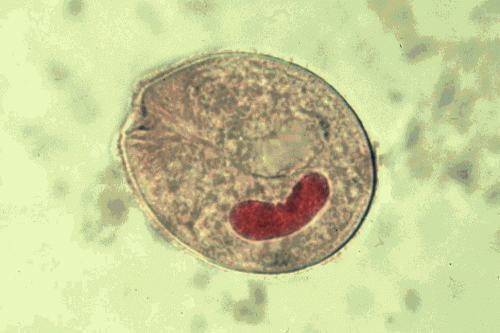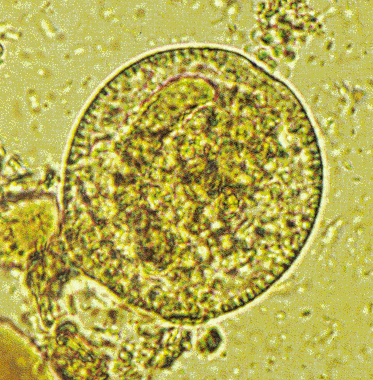by Piter Kehoma Boll
It’s time to give more space for parasites, including human parasites! So today our fellow comes right from the stool of many mammals, including humans. Its name is Balantidium coli, or B. coli for short.
B. coli is a ciliate, i.e., a member of the phylum Ciliophora, a group of protists that have their cells covered by cilia, which are nothing more than very short and numerous flagella. Most ciliates are free-living organisms, and in fact B. coli is the only ciliate known to be harmful to humans, but not only to humans. Many other mammals are also known to host this fellow, especially pigs.

The red elongate macronucleus of B. coli makes it look like a bad guy, don’t you think? Photo extracted from http://www.southampton.ac.uk/~ceb/Diagnosis/Vol2.htm
The typicall habitat of B. coli is the large intestine of mammals. The protist lives there in an active phase called trophozoite (seen in the image above) and feeds on the natural bacteria that live in the gut. When facing dehydration, which happens in the final portion of the intestine or after the organism is released with the feces, B. coli changes to an inactive phase called cyst, which is smaller than the trophozoite and covered by a thick wall. The cysts released in the environment may be ingested by a new host and reach their intestine, where they will return to the trophozoite form.

A cyst of B.coli. Photo extracted from http://www.southampton.ac.uk/~ceb/Diagnosis/Vol2.htm
Symptoms of infection by B. coli, also known as balantidiasis, include explosive diarrhea every 20 minutes and, in acute infections, it may cause perforation of the colon and become a life-threatening condition.
Fortunately, infection in humans is not that common. The most affected country nowadays are the Philippines, but you may get infected anywhere. The best way to reduce the infection risks is by having good sanitary conditions and personal hygiene. However, as pigs are the most common vectors of the disease, it will likely continue to exist as long as humans raise pigs.
– – –
Schuster, F., & Ramirez-Avila, L. (2008). Current World Status of Balantidium coli Clinical Microbiology Reviews, 21 (4), 626-638 DOI: 10.1128/CMR.00021-08
Wikipedia. Balantidium coli. Available at <https://en.wikipedia.org/wiki/Balantidium_coli>. Access on February 23, 2017.

Pingback: Friday Fellow: Swan Lacrymaria | Earthling Nature